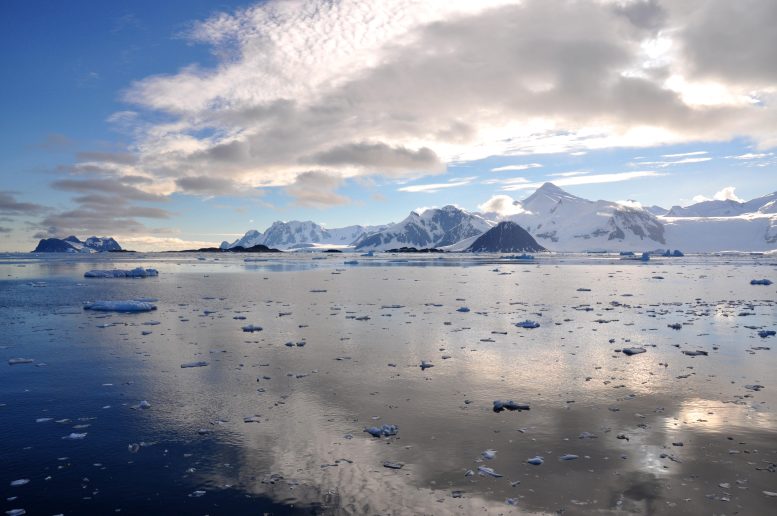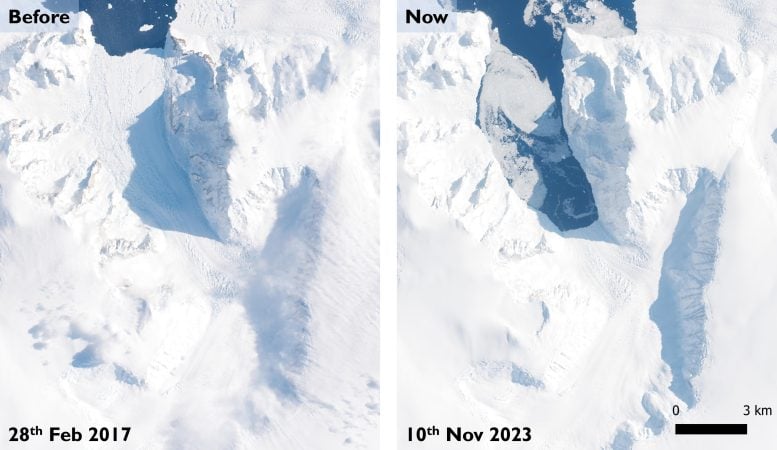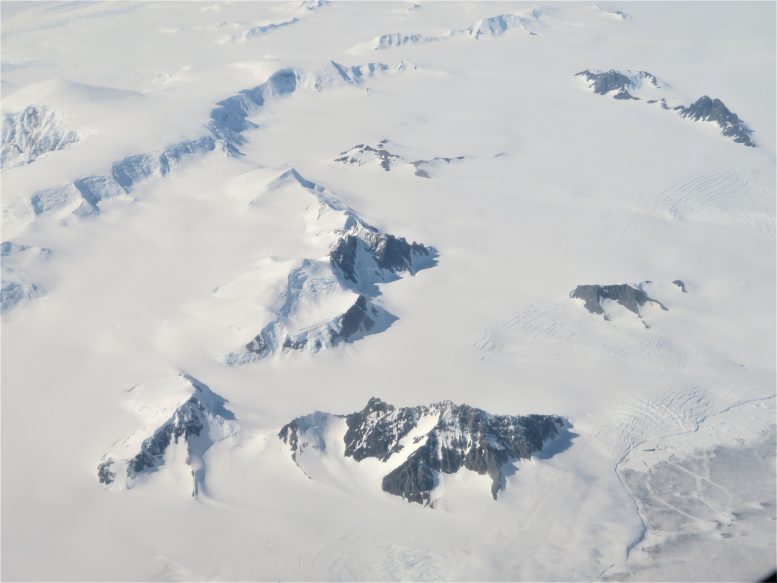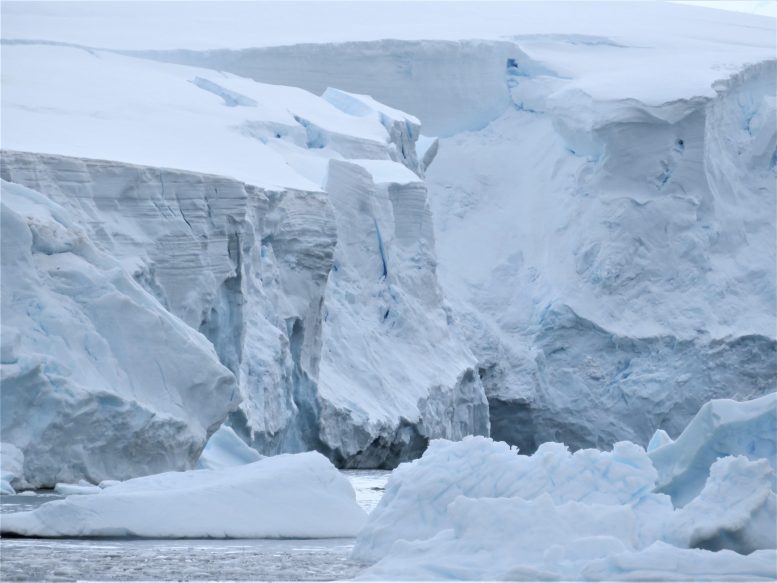
Scientists have found that even seemingly stable glaciers in the Antarctic can “switch very rapidly” and lose large quantities of ice as a result of warmer oceans. This alert follows a study by a team led by glaciologist Benjamin Wallis from the University of Leeds. Using satellite data, the team observed significant changes in the Cadman Glacier, located in the Beascochea Bay area of the West Antarctic Peninsula.
Between November 2018 and May 2021, the glacier retreated eight kilometers as the ice shelf at the end of the glacier — where ice extends out into the sea and is anchored onto the sea floor at what is known as the grounding zone — collapsed.
The ice shelf would have acted as a buttress, slowing the movement of the glacier towards the sea. Surrounded by warmer ocean waters, the scientists believe the ice shelf thinned and became ungrounded, and the ice shelf was no longer able to hold back the glacier.
As a result, the speed at which the glacier was flowing rapidly accelerated — doubling its speed — increasing the amount of ice it discharges into the sea as icebergs, through a process known as iceberg calving.
Wallis said: “We were surprised to see the speed at which Cadman went from being an apparently stable glacier to one where we see sudden deterioration and significant ice loss.

“What was also curious was that the neighboring glaciers on this part of the west Antarctic Peninsula did not react in the same way, which may hold important lessons for the way we can better project how climate change will continue to affect this important and sensitive polar region.
“Our study brought together data from three decades, nine different satellite missions, and in-situ oceanographic measurements to understand the changes happening in Antarctica. This demonstrates how important it is to have long-term monitoring of the Earth’s polar regions with a range of sensors which all tell us a different piece of the story.”
According to the scientists, the Cadman Glacier is now in a state of “substantial dynamic imbalance”. The ice on the glacier has continued to thin, with elevation being lost at a rate of around 20 meters a year. That is equivalent to a loss in height of a five-story building each year.
And around 2.16 billion tonnes of ice are draining from the Cadman Glacier into the ocean each year. The researchers have published their analysis — Ocean warming drives rapid dynamic activation of marine-terminating glacier on the west Antarctic Peninsula — in the scientific journal Nature Communications.

Why the Cadman Glacier became so unstable
Unusually high ocean water temperatures in early 2018/19 around the west Antarctic peninsula are believed to have triggered the rapid dynamic change on the Cadman Glacier system. By analyzing historic satellite data, the scientists believe warmer ocean waters gradually thinned the glacier’s ice shelf from the early 2000s and possibly since the 1970s.

The warmer water was not carried on the surface of the ocean but deep in the water column. This warmer water may have reached the ice shelf where it is grounded on the sea floor. The result is the ice shelf begins to melt from the bottom up. In 2018/19, the ice shelf was so thin that it broke free from the grounding zone and started to float, in effect slipping anchor and enabling the Cadman Glacier to drain more ice into the seas.
But the scientific team still faced one big question. Why had the Cadman Glacier collapsed when the neighboring Funk and Lever Glaciers remained relatively stable?
Subsea ridges protect some glaciers
By analyzing subsea oceanographic data, they believe a series of subsea rock structures called ridges or sills, at a depth of 200 meters and 230 meters, acts as a defensive barrier, deflecting channels of warmer water from reaching the glaciers. Although they warn that a rise in ocean warming could compromise the ability of the ridges to protect some glaciers.
Professor Michael Meredith, from the British Antarctic Survey and one of the authors of the paper, said: “We have known for some time that the ocean around Antarctica is heating up rapidly and that this poses a significant threat to glaciers and the ice sheet, with consequences for sea level rise globally.
“What this new research shows is that apparently stable glaciers can switch very rapidly, becoming unstable almost without warning, and then thinning and retreating very strongly. This emphasizes the need for a comprehensive ocean observing network around Antarctica, especially in regions close to glaciers that are especially hard to make measurements.”
Writing in the paper, the researchers say what has happened to the Cadman Glacier can be seen as an example of a “glaciological tipping point,” where a system in a steady state can take one or two paths based on a change in an environmental parameter.
A tipping point was reached in 2018 caused by the arrival of unusually warm ocean water, which caused the ice shelf to unground. Reaching this tipping point caused the Cadman Glacier to increase its ice discharge by 28% in 13 months.
The researchers say other glaciers on the Antarctic Peninsula may be vulnerable to similar sudden changes because of subsea geology.
Reference: “Ocean warming drives rapid dynamic activation of marine-terminating glacier on the west Antarctic Peninsula” by Benjamin J. Wallis, Anna E. Hogg, Michael P. Meredith, Romilly Close, Dominic Hardy, Malcolm McMillan, Jan Wuite, Thomas Nagler and Carlos Moffat, 28 November 2023, Nature Communications.
DOI: 10.1038/s41467-023-42970-4
The study was funded by the Natural Environment Research Council, the European Space Agency, the European Commission, and the National Science Foundation.
1 Comment
“We have known for some time that the ocean around Antarctica is heating up rapidly and that this poses a significant threat to glaciers and the ice sheet, with consequences for sea level rise globally.”
West Antarctica is an extension of the Pacific Rim of Fire. It is home to active volcanoes and areas of high geothermal heat flow under the ice. There are also a high number of seamounts under water. Yet, there is no mention of that. They remark, “The warmer water was not carried on the surface of the ocean but deep in the water column.” Where is the heat coming from that has warmed the deep water? If it isn’t at the surface, why not? Warm water is typically less dense than cold water and should rise. If global warming is a result of down-welling infrared radiation, it should be warming the surface waters. Why isn’t it? The situation doesn’t make sense and the authors haven’t explained it. They are making assertions and ignoring the proverbial ‘Elephant in the Room.’